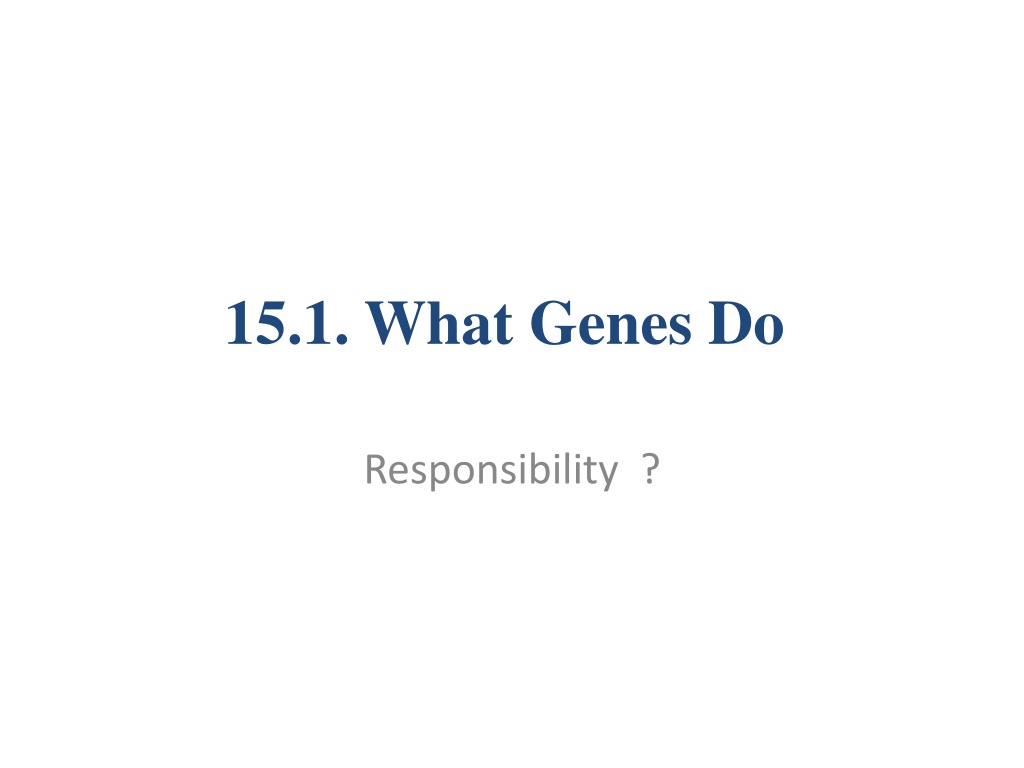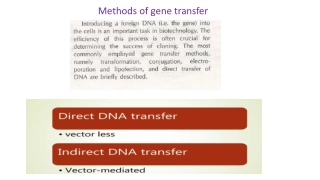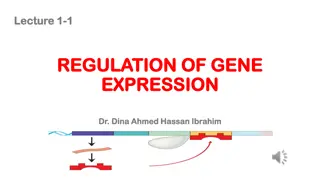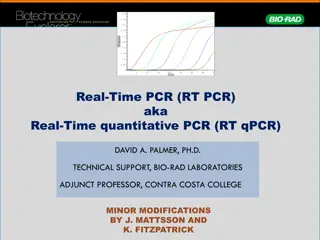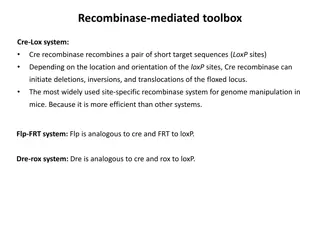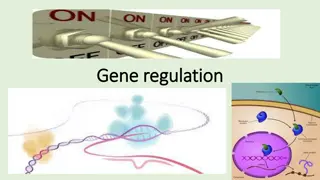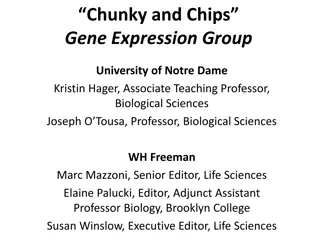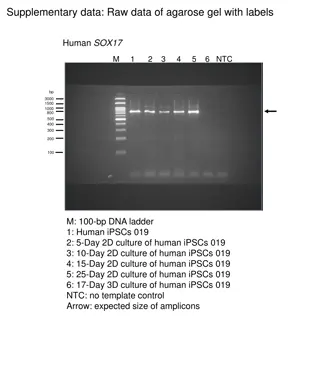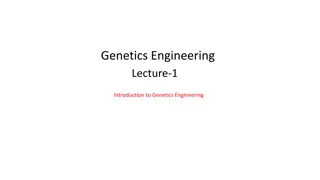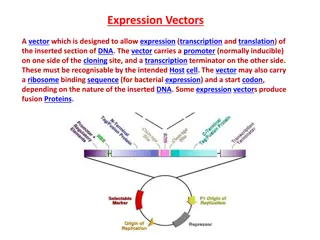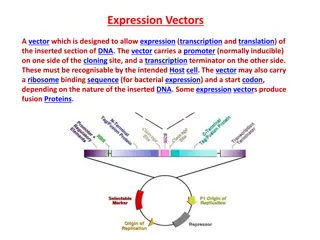Understanding Gene Function and Expression in Molecular Genetics
Investigating gene function and expression is crucial in molecular genetics. Key discoveries by pioneers like Archibald Garrod, George Beadle, Edward Tatum, Linus Pauling, and Vernon Ingram have shed light on how genes are responsible for enzyme synthesis, polypeptide specification, and protein synthesis. The relationship between genes, DNA, and RNA in directing protein synthesis is explored, emphasizing the essential role of RNA as an intermediary between nuclear coding and cytoplasmic protein production.
Download Presentation

Please find below an Image/Link to download the presentation.
The content on the website is provided AS IS for your information and personal use only. It may not be sold, licensed, or shared on other websites without obtaining consent from the author. Download presentation by click this link. If you encounter any issues during the download, it is possible that the publisher has removed the file from their server.
E N D
Presentation Transcript
15.1. What Genes Do Responsibility ?
A. Investigators Recognize Gene Activity 1. English physician Archibald Garrod introduced phrase inborn error of metabolism. a. Garrod said inherited defects could be caused by the lack of a particular enzyme. b. Knowing that enzymes are proteins, Garrod suggested link between genes and proteins.
B. Genes Specify Enzymes 1. George Beadle and Edward Tatum X-rayed spores of red bread mold, Neurospora crassa. 2. Discovered some resulting cultures lacked a particular enzyme for growth on medium. 3. They found that a single gene was mutated, which resulted in the lack of a single enzyme. 4. They stated one gene one enzyme hypothesis: one gene specifies synthesis of one enzyme.
C. Genes Specify a Polypeptide : 1. Pauling and Itano compared hemoglobin in red blood cells of persons and normal individuals. 2. Discovered chemical properties of chain of sickle-cell Hb. differed from normal Hb by using electrophoresis to separate molecules by weight and charge. 3. Pauling and Itano formulated the one gene - one polypeptide hypothesis: each gene specifies one polypeptide of a protein, a molecule that may contain one or more different polypeptides. 4. Vernon Ingram showed the biochemical change to chain of sickle-cell Hb is due to substitution of non-polar amino acid valine for negatively charged amino acid glutamate.
How Genes Are Expressed : A. Gene-product Relationship 1. Classical geneticists conceived of a gene as any of the particles of inheritance on a chromosome. 2. To molecular geneticists, a gene is a sequence of DNA nucleotide bases that codes for a product. 3. Relationship of sequence of nucleotides in a DNA polymer and linear sequence of amino acids in polypeptides suggests nucleotide sequence of DNA determines amino acid sequence in proteins. 4. A DNA molecule cannot directly control the sequence of amino acids because DNA is restricted to nucleus of eukaryotes except during cell division and the nucleoid in prokaryotes; protein synthesis occurs in cytoplasm. 5. There must be go-between nuclear coding and cytoplasmic protein synthesis; ribonucleic acid (RNA) was found in both regions and was likely intermediary in process of protein synthesis.
B. RNA Is Involved : 1. Like DNA, RNA is a polymer of nucleotides. . 2. Unlike DNA, RNA is single-stranded, contains the sugar ribose, and contains the base uracil instead of thymine. . 3. There are three major classes of RNA. a. Messenger RNA (mRNA) takes a message from DNA in nucleus to ribosomes in cytoplasm. b. Ribosomal RNA (rRNA) and proteins make up ribosomes where proteins are synthesized. c. Transfer RNA (tRNA) transfers a particular amino acid to a ribosome.
C. Several Steps Are Involved: 1. Central dogma of molecular biology: DNA undergoes transcription to mRNA, which is translated to a protein. 2. DNA is a template for its own replication and also for RNA formation during transcription. 3. Transcription: is the first step in gene expression; it is the process when DNA strand serves as a template for the formation of mRNA. a. Most often mRNA formation leads to a polypeptide as the gene product. b. tRNA and rRNA are transcribed from DNA templates; these are products in and of themselves. 4. Complementary sequence of nucleotides in mRNA orders correct sequence of amino acids of polypeptide during translation
How Genes Code for Amino Acids : A. Sequence of Bases in DNA: 1. Codes for proper sequence of amino acids in a polypeptide. 2. genetic code: is a triplet code comprised of 64 of (three-base code) words called (codons). 3. Codon consists of 3 nucleotide bases of DNA or mRNA; codes for amino acid or ends translation.
B. Finding the Genetic Code 1. In 1961, Marshall Nirenberg and J. Heinrich Matthei found an enzyme that could be used to construct synthetic RNA; discovered the codon UUU coded for phenylalanine. 2. The code is degenerate; there are 64 triplets to code for 20 naturally occurring amino acids. 3. The genetic code is unambiguous; that is, each triplet codon has only one meaning. 4. The code has start and stop signals: there is one start codon and three stop codons. C. The Code Is Universal 1. The few exceptions to universality of the genetic code suggests code dates to very first organisms. 2. Once the code was established, changes would be very disruptive.
How Transcription, Occurs : A. Transcription: 1. The first step required for gene expression. 2. mRNA formation usually leads to a polypeptide gene product; however, tRNA and rRNA are also transcribed from DNA templates and are products themselves. 3. Enzymes called RNA polymerases are involved in transcription.
B. Messenger RNA is Formed: 1. Transcription begins when RNA polymerase attaches to a promoter on DNA. 2. RNA polymerase is an enzyme that speeds formation of RNA from a DNA template. 3. Promoter is DNA region that defines start of gene, direction of transcription, and strand copied. 4. Next, a segment of the DNA helix unwinds and unzips.
C. RNA Polymerase : 1. As RNA polymerase moves along the template strand of the DNA, complementary RNA nucleotides pair with DNA nucleotides of the strand. 2. RNA polymerase joins the RNA nucleotides together with DNA nucleotides 3- Elongation of the mRNA molecule occurs as long as transcription proceeds. 4. RNA/DNA association is not as stable as DNA helix; therefore, only newest portion of RNA molecule associated with RNA polymerase is bound to DNA; the rest dangles off to side. 5. RNA polymerase finally comes to terminator sequence at other end of gene being transcribed. 6. Terminator sequence causes RNA polymerase to stop transcribing DNA, and to release mRNA transcript. 7. RNA polymerase molecules work to produce mRNA from same DNA molecule at same time. 8. Cells produce thousands of copies of same mRNA molecule and many copies of coded protein in a shorter period of time than if a single copy of DNA were used for protein synthesis.
D. Messenger RNA is Processed : 1. In eukaryotes, newly formed primary mRNA transcript is processed before leaving nucleus. 2. Primary mRNA transcript is immediate product of transcription; contains exons and introns. 3. Ends of the mRNA molecule are altered: a cap is put on 5' end and a poly-A tail is put on 3' end. a. "Cap" is a modified guanine (G) that tells a ribosome where to attach to begin translation. b. The "poly-A tail" consists of a 150-200 adenine (A) nucleotide chain, of unknown function. 4. Portions of the primary mRNA transcript, called introns, are removed. a. Exon is portion of DNA code in primary mRNA transcript eventually expressed as result of polypeptide synthesis. b. Intron is noncoding segment of DNA removed by spliceosomes before mRNA leaves nucleus. 5. Spliceosomes :a complex that contains several kinds of ribonucleoproteins; it cuts primary mRNA transcript and then rejoins adjacent exons.
How Translation Occurs : A. Translation: 1. Takes place in cytoplasm of eukaryotic cells. 2. Translation is second step of gene expression leads to protein synthesis. 3. One language (nucleic acids) is translated into another language (protein). B. Transfer RNA Transfers Amino Acids 1. Transfer RNA (tRNA) molecules transfer amino acids to the ribosomes. 2. tRNA is a single-stranded ribonucleic acid that doubles back on itself . 3. At one end it binds to amino acid; at other end it has an anticodon that binds to mRNA codon; anticodon is group of nucleotides on a tRNA molecule complementary to codon on mRNA.
5. tRNA synthetases are amino acid-activating enzymes that recognize which amino acid should join which tRNA molecule, and then catalyze ATP- requiring reactions joining them. 6. Amino acid-tRNA complex forms, then travels in cytoplasm to ribosome for protein synthesis. 7. As anticodons of tRNA molecules bind to codons of mRNA molecule, amino acids become sequenced in polypeptides according to information provided by gene; tRNAs accomplish translation, converting nucleic acid code into amino acid sequence.
C. Ribosomal RNA Is Structural 1. Ribosomal RNA (rRNA) is produced off a DNA template in the nucleolus of nucleus. 2. rRNA is packaged with a variety of proteins into ribosomal subunits, one larger than the other. 3. Subunits move separately through nuclear envelope pores into cytoplasm where they combine. 4. Ribosomes can float free in cytosol or attach to endoplasmic reticulum. 5. Prokaryotic cells contain about 10,000 ribosomes; eukaryotic cells contain many times more. 6. Ribosomes have a binding site for mRNA and binding sites for two transfer RNA (tRNA) molecules.
7. They facilitate complementary base pairing between tRNA anticodons and mRNA codons; one protein is an enzyme that joins amino acids together by means of a peptide bond. 8. Ribosome moves down mRNA molecule, new tRNAs arrive; amino acids join; polypeptide forms. 9. Translation terminates once polypeptide is formed; ribosome dissociates into its two subunits. 10. Polyribosomes are clusters of several ribosomes synthesizing the same protein. . 11. Ribosomes are first free in cytosol; once synthesis begins, some have series of amino acids called signal sequence that enables ribosome to bind to endoplasmic reticulum. 12. Nearly all polypeptides have signal sequences that target them for final location in cell.
D. Translation Requires Three Steps 1. In translation, mRNA codons base-pair with tRNA anticodons carrying specific amino acids. 2. Codon order determines order of tRNA molecules and sequence of amino acids in polypeptides. 3. Protein synthesis involves chain initiation, chain elongation, chain termination. . 4. Enzymes are required for all three steps; energy is needed for first two steps. 5. Chain Initiation : a. Small ribosomal subunit attaches to mRNA in vicinity of the start codon: a base triplet (AUG). b. First or initiator tRNA pairs with this c. Each ribosome contains two sites: the P (for peptide) site and the A (for amino acid) site.
d. Initiator tRNA binds to P site although it carries one amino acid; the A site is for next tRNA. e. Initiation factor proteins are required to bring necessary translation components together. 6. Chain Elongation : a. tRNA with attached polypeptide is at P site; tRNA-amino acid complex is just arriving at A site. b. The polypeptide is transferred and attached by a peptide bond to the newly arrived amino acid. c. Reaction is catalyzed by a ribozyme, which is part of the larger subunit. d. The tRNA molecule in the P site leaves. e. Translocation occurs with mRNA, along with peptide-bearing tRNA, moves from site A to P. f. As ribosome has moved forward three nucleotides, there is new codon located at empty A site. g. The complete cycle is rapidly repeated, about 15 times per second in Escherichia coli.
7. Chain Termination: a. Termination of polypeptide synthesis occurs at stop codon that does not code for amino acid. b. The polypeptide is enzymatically cleaved from the last tRNA. c. tRNA and polypeptide leave the ribosome, which dissociates into its two subunits. . E. Let's Review Gene Expression . 1. DNA is genetic information; sequence of bases determines sequence of amino acids in polypeptide. 2. During transcription, one strand of DNA serves as a template for the formation of mRNA.
Mutations Are Base Changes : A. Gene Mutations---Alteration in Nucleotide Sequence of DNA. B. Frameshift Mutations Are Drastic 1. Reading frame depends on sequence of codons from starting point: THE CAT ATE THE RAT. 2. If C is deleted, the reading frame is shifted: THE ATA TET HER AT. 3. Frameshift mutations occur when one or more nucleotides are inserted or deleted from DNA. 4. The result of a frameshift mutation is frequently a nonfunctional protein. C. Point Mutations Can Be Drastic 1. Point mutation changes a single nucleotide and therefore changes a single specific codon. 2. They can range in effect depending on the particular codon change. . 3. Changes to codons that have same effect are silent mutations; UAU to UAC both code tyrosine. 4. A change from UAC to UAG (a stop codon) results in a shorter protein, a nonsense mutation. 5. A change from UAC to CAC incorporates histidine instead of tyrosine, a missense mutation.
D. Cause and Repair of Mutations 1. Mutations due to DNA replication errors are rare. 2. DNA polymerase constantly monitors, proofreads new strand against old, and repairs any irregularities, reducing mistakes to one out of every one billion nucleotide pairs replicated. 3. Mutagens : are environmental substances that cause mutations. a. Common mutagens are radiation and organic chemicals such as some pesticides and smoke. b. If mutagens cause mutation in gametes, then offspring may be affected like as syndrome or defects . c. If the mutation occurs in the body cells, then cancer may result. d. Everyone is exposed to UV radiation; it penetrates skin and breaks DNA of underlying tissues.
Q: Explain Beadle and Tatums experimental procedure Q: How is mRNA processed before leaving the eukaryotic nucleus Q:Numerous the types of Mutation and Explain the Actions in translation. Q: discuss the following statements:- 1-DNA replication is considered semiconservative 2- Bacteria Can Be Transformed
In molecular biology and genetics, translation is the process in which ribosomes in the cytoplasm or endoplasmic reticulum synthesize proteins after the process of transcription of DNA to RNA in the cell's nucleus. The entire process is called gene expression.
